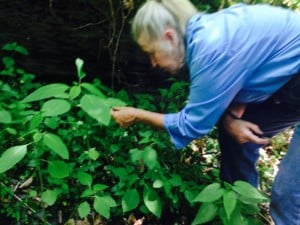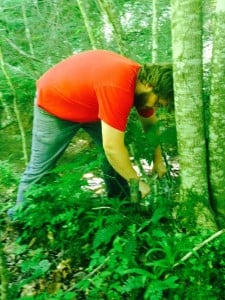The native landscape of Eastern Kentucky has healed and nourished people for thousands of years. Our hills support thousands of species of plants; many of which have great benefit to us. From the sacred ground nut of the Cherokee to Maw’s fried poke, the history of our relationship with plants runs as deep as the hollers.…
Saturday morning, we gathered at the Cowan Community Center for a workshop to learn and share our own stories on wild edible and medicinal plants. Cody Montgomery, conducted the workshop. Cody had a great slideshow of native plants and then led a guided walking through Kingdom Come Creek.
Nell Fields, President of Cowan Community Action Group welcomed the group and gave a short demonstration on preparing poke and how to make poke patties. Participants had been invited to bring in samples of the wild plants they eat. We had a nice variety of plants.
Our group was a little smaller at this gathering with about 35 here to learn and share stories of plants in our region. Our group is getting more comfortable w/sharing their own experiences and knowledge. When Cody showed the Spicewood plant, several in the room had stories of their mothers or grandmothers cooking with this, although rarely served now, it was used for flavoring opossum. Some in the crowd had known it to be used in lye soap. We found this plant on our tour and it will be remembered.
Cody did a great job highlighting the biodiversity of Eastern Kentucky and how rich and well suited our environment is for so many plants. Naturally, we talked of ginseng, but other valued roots and plants were introduced to participants that could be wildcrafted and are well suited for our mountains.
Cody kept handy for reference and recommended the Pettersons Field Guide for identifying and recognizing plants. Although this was a well informed crowd, we stressed to our group that our intent was to share the history of our culture and relationship with native plants through the years. Participants may choose to research further, but our intent was not to encourage the use of these plants without thorough research beyond the days workshop. Cody shared some plants that were toxic and cautioned the group strongly to be educated and informed before consuming any plants.
After we finished the morning slide show and talk, several loaded up for a tour through Kingdom Come Creek. It was a beautiful day for walking AND driving in the creek to find many of the plant species Cody had mentioned. It was a beautiful day to be outside and take time to appreciate all the plants and each other. Thanks to Angie Hatton Mullins for photos on the walking tour.
Cody has offered to send and share his slide show which has the plants picture and common names. When I get that I will add to this post. In the meantime, the picture is worth a thousand words.





















Valerie,
Congratulations on another most interesting, informative, and fun activity for our Grow Appalachia participants. I am sorry I couldn’t attend, but it gave my husband and me a conversation piece for about 50 miles as we traveled to shop Sat. after the program. The pictures of the plants on Kingdom Come Creek were awesome, and even after growing up in a family who ate wild greens every year as soon as the leaves poked through the ground, I did not recognize the ones he was demonstrating. Cody evidently knew his subject really well, and really knew how to engage his audience. Again, thanks for bringing such a quality program to the Cowan Community Center.
Carol Ison, Director
Cowan Community Center